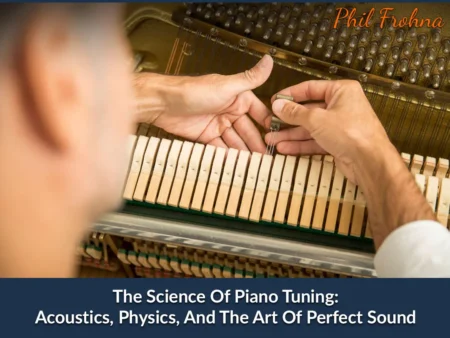 Piano tuning is a fascinating blend of art and science. Producing a harmonious sound requires a deep understanding of the instrument’s acoustics and physics. For any piano tuner, especially those in bustling music scenes like Tampa, mastering these principles is essential to enhancing the performance and longevity of this beloved instrument.
Piano tuning is a fascinating blend of art and science. Producing a harmonious sound requires a deep understanding of the instrument’s acoustics and physics. For any piano tuner, especially those in bustling music scenes like Tampa, mastering these principles is essential to enhancing the performance and longevity of this beloved instrument.
The Foundation of Piano Sound: Strings and Soundboards
At its core, a piano produces sound through strings stretched over a soundboard. When a key is pressed, a hammer strikes one or more strings, causing them to vibrate. These vibrations are transferred to the soundboard, which amplifies them and creates the rich, resonant tones we associate with the piano. The precise length, tension, and mass of each string determine the pitch of the notes they produce. This is where the physics of sound waves plays a crucial role.
The Role of Harmonics in Piano Tuning
One of the critical concepts in piano tuning is understanding harmonics or overtones. These are higher-frequency sounds produced when a string vibrates, in addition to the fundamental frequency. Each string produces a series of harmonics that are integral to the character of the piano’s sound. When tuning a piano, a tuner listens not only for the fundamental pitch but also for these harmonics to align perfectly across all the strings.
This alignment is crucial because it affects the timbre and richness of the sound. If the harmonics are not correctly aligned, the piano will sound out of tune, even if the fundamental frequencies are correct. This is particularly challenging in a humid city like Tampa, where wood can swell and contract, subtly altering the tension and, thus, the piano’s tuning over time.
Temperament and Tuning Systems
Piano tuning also involves choosing the right temperament or tuning system. Historically, tuners used just intonation based on pure harmonic ratios, but this system did not allow instruments to change keys smoothly. Modern pianos typically use equal temperament, where the octave is divided into twelve equal steps. This allows for consistent tuning across all keys, which is especially important for versatile performance demands, such as those faced by pianists in Tampa’s diverse music venues.
A piano tuner uses sophisticated tools and techniques to adjust the tension of each piano string to achieve this equal temperament. This process requires not only an understanding of the physical properties of the strings but also an ear trained to detect minute differences in pitch and tone.
The Impact of Physics: String Tension and Length
The physics behind string tension and length is another critical aspect of piano tuning. The tension of a string must be precisely controlled to produce the correct pitch. This tension is adjusted by turning the tuning pins, which can be a delicate process. If the tension is too high, the string may break; if it’s too low, the note will sound flat. Additionally, the length and thickness of the strings affect their tension and, consequently, the pitch. Bass strings, for instance, are thicker and longer, requiring different tuning considerations than treble strings.
The Art of Listening and Adjusting
Ultimately, the science of piano tuning is about understanding and manipulating the physical properties of the piano to produce the desired sound. This requires a blend of technical knowledge and sensory skills. A good piano tuner combines a sharp ear with an understanding of acoustics and physics to keep pianos sounding their best. For those in Tampa, engaging a professional piano tuner from a dedicated service like Tampa Piano Tuning can ensure your instrument receives the meticulous care it deserves. Whether it’s a concert grand in a large venue or an upright in a home, every piano benefits from the expertise of a knowledgeable tuner. This blend of science and art ensures that the music never stops resonating beautifully.
Picture Credit: VistaCreate